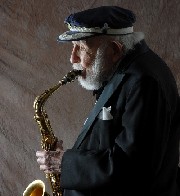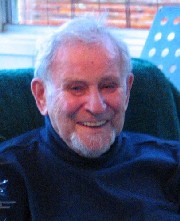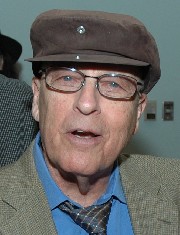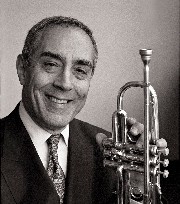Allegro
Requiem
Volume CVIII, No. 11November, 2008
Jane Cochran – Oboe/English Horn
Joseph Frances Diamond – Piano
Alfred J. Gallodoro – Saxophone
Nathan Gershman – Cello
Neal Hefti – Trumpet
Michael Kania – Accordion
Roy Ray – Trumpet
Richard M. Sudhalter – Trumpet

|
Alfred J. Gallodoro, 95, a saxophonist, clarinetist and bass clarinetist, and an 802 member since 1934, died on Oct. 4.
Mr. Gallodoro appeared in all forms and venues of music, from vaudeville houses to New Orleans speakeasies, from nightclubs to symphonies, and from Carnegie Hall to international jazz festivals. His longest association was with Paul Whiteman, where Mr. Gallodoro played lead first alto sax — as well as clarinet and bass clarinet — for nearly 40 years.
Mr. Gallodoro performed classical music as well as jazz under famed conductors Isham Jones, Arturo Toscanini, Leopold Stokowski, Alfredo Antonini, Leonard Bernstein, Andre Kostelanetz, Johnny Green, Tutti Camarata, Arthur Fiedler, Percy Faith, Skitch Henderson and Dr. Frank Black.
He also performed with George Gershwin, Victor Borge, Dinah Shore, Sid Caesar, Raphael Mendez, Les Paul, Bob Hope, Edgar Bergen, Duke Ellington, Tommy Dorsey, Mario Lanza, Frank Sinatra and Milton Berle .
According to his Web site, Mr. Gallodoro holds the world’s record for the most performances of the clarinet slide in Gershwin’s “Rhapsody in Blue” – over 10,000 times. Just two years ago, Mr. Gallodoro was called upon to perform and record the piece with conductor Steven Richman’s Harmonie Ensemble Orchestra.
He is survived by his daughters Mary Bruggeman, Joann Gallodoro and Alice Gallodoro, brother Frank Gallodoro, sisters Frances Nyhan and Catherine Gagliano, as well as 18 grandchildren (including grandson Kevin Wood, his producer), 29 great-grandchildren, and 8 great-great grandchildren. He is also survived by his manager Joann Chmielowski.
Erwin Price interviewed Al Gallodoro for Allegro in 1999. To read the interview, click here.

|
Nathan Gershman, 90, a cellist and an 802 member since 1948, died on Sept. 13.
Mr. Gershman was a graduate of the Curtis Institute, where he studied with Orlando Cole and Felix Salmond. He began his professional career with the Cleveland Orchestra, where he spent seven years, before moving to New York City and taking a job with the Radio City Music Hall orchestra.
Mr. Gershman later moved to California where he freelanced and was eventually picked up by Chico Hamilton, with whose quintet he toured nationally. His son Gene wrote that he remembered his father “telling the story about what a departure this was from his classical roots and how nervous he was at the prospect of having to improvise.”
Mr. Gershman later returned to California and continued to freelance for movies, TV shows, theatre and recording dates. He worked with many of the great pop singers.
He is survived by his wife Alice, sons Gene, William and Wayne, and granddaughters Julia, Nikki and Brooke.

|
Neal Hefti, 85, the Grammy-award winning composer, arranger and trumpeter, died on Oct. 11. He had been a Local 802 member since 1942.
Mr. Hefti began arranging professionally in his teens, when he wrote charts for Nat Towles. He became a prominent composer and arranger while playing trumpet for Woody Herman; while working for Herman he provided new arrangements for “Woodchopper’s Ball” and “Blowin’ Up a Storm,” and composed “The Good Earth” and “Wild Root.” After leaving Herman’s band in 1946, Hefti concentrated on arranging and composing, although he occasionally led his own bands. He is especially known for his charts for Count Basie, such as “Li’l Darlin’” and “Cute.”
In the 1960’s and later Mr. Hefti composed and arranged mainly for movies and television. He wrote the background music for movies such as “Sex and the Single Girl,” “How to Murder Your Wife,” “Synanon,” “Boeing Boeing,” “Harlow,” “Lord Love a Duck,” “Duel at Diablo,” “Oh Dad Poor Dad Mama’s Hung You in the Closet and I’m Feelin’ So Sad” and “Barefoot in the Park.”
His best-known compositions for TV included the themes to “Batman” (for which he won a Grammy) and “The Odd Couple.”
In addition to his son Paul, a music composer, Mr. Hefti is survived by his brother Joe, sister Pat Wacha and three grandchildren.
Edited from Wikipedia.

|
Richard M. Sudhalter, 69, a Local 802 member since 1975, died on Sept. 19. He played trumpet, flugelhorn and piano and was also a scholar, critic and album annotator.
Born in Boston, Massachusetts, Mr. Sudhalter was inspired to pursue a musical career by his father Al Sudhalter, a noted Boston-area saxophone soloist. He began playing the cornet at 12 and within a few years was performing professionally. After graduating from Oberlin College, he moved to Europe in 1960, later becoming a United Press International correspondent. In 1968 he covered the Russian invasion of Czechoslovakia from Prague for UPI. He wrote jazz criticism for the New York Post from 1978 to 1984.
In 1974, Mr. Sudhalter and Philip R. Evans co-wrote “Bix: Man and Legend,” the standard biography of jazz cornetist Bix Beiderbecke. He also wrote “Lost Chords: White Musicians and Their Contribution to Jazz, 1915-1945” and “Stardust Melody,” the first full-length biography of Hoagy Carmichael. He won a Grammy in 1983 for his liner notes for “Bunny Berigan: Giants of Jazz.”
Mr. Sudhalter played trumpet and cornet with the New York Jazz Repertory Company and founded the New Paul Whiteman Band. In 1983 he co-founded the Classic Jazz Quartet, a traditional jazz ensemble that included Marty Grosz on guitar, Joe Muranyi on clarinet and Dick Wellstood on piano.
He is survived by his partner Dorothy Kellogg, sister Carol, brother James, and daughters Adrian and Kimberly.
Edited from Wikipedia.
